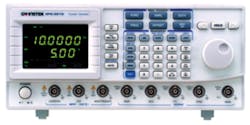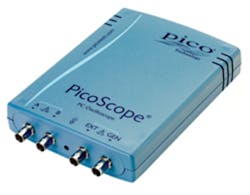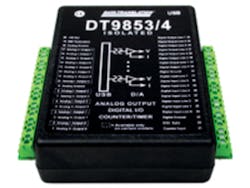How do you design a signal source with good performance that can sell for $1,000 or less? Three approaches are evident in many products currently on the market. Integration and disaggregation are two of the themes, and they are not as incompatible as they may appear. Integration is applied to circuit functionality and disaggregation to the much larger parts of a traditional instrument such as the power supply, display, and chassis.
Disaggregation is a major principle behind PC-based instruments. If you don’t need a separate display, control panel, or power supply, suddenly the chassis becomes much smaller. Maybe the amount of costly sheet metal can be limited to only some shielding. The physical requirements to protect, house, and support may be met by a lower cost molded case.
The real cost of a PC-based instrument must include some portion of the PC itself and associated cables and software. If you already have a suitable PC, then only adding in the instrument’s incremental cost may be appropriate. Similar arguments can be made for modular instruments that plug into a PXI or VXI chassis. How you account for the cost of the signal source depends on the amount of additional equipment you must purchase to use it.
Of course, not all applications require state-of-the-art performance. Signal source performance generally reduces along with price. So, the third theme is simplification. Rather than poorly mimicking all the features of a high-priced instrument, many low-cost sources do a good job of providing basic capabilities.
As an example, L-3 Nova Engineering’s NovaSource G6™ RF Signal Sources cover the 65-MHz to 5.875-GHz range in 15 models. They support frequency modulation up to 100 kHz as well as frequency sweeping so they are more advanced than competing CW-only RF/microwave sources. The NS3-0800102 offers 1-kHz step size from 800 MHz to 1,200 MHz and typical SSB phase noise of -80 dBc/Hz at 10-kHz offset. List price for this model is $1,149.
Several companies make precision RF/microwave signal generators, and the Giga-tronics 2500B Series is among those with the highest performance. Six models cover the 100-kHz to 50-GHz range, but even the lowest frequency SB2502B model handles 100 kHz to 2.5 GHz with 0.001-Hz resolution. Phase noise is almost -130 dBc @ 10-kHz offset from a 1-GHz carrier. Interestingly, the spurious and harmonic noise contributions are similar for the 2502B and G6 instruments.
It’s true that at $17,900 the Model 2502B costs more than 15x the G6 although the 2502B is a stand-alone instrument and you need a PC host as well as an external 9-VDC supply for the G6. However, should you want to run tests in another frequency range, you must buy a different G6 model. With the Giga-tronics 2502B, you simply switch ranges. In fact, frequency switching is one of the 2502B’s strong points. The exact amount of time depends on both the size of the change and its direction, but as an example, a 10-MHz change takes about 200 µs compared to milliseconds for the G6.
Conversely, sweeping might be fine with the G6 because even a range of a few megahertz would have thousands of data points. Nevertheless, undersampling applications often require an extremely accurate clock frequency to achieve the desired aliasing. The 2502B’s fine resolution easily addresses this kind of work where the NovaSource’s 1-kHz step size could be a limitation.
L-3 Nova Engineering positions the product range as a low-cost alternative to traditional signal generators. It claims that the NovaSource is what remains after all the extraneous features are eliminated from a high-priced generator. Of course, if your test application requires features such as fast switching, list mode, and built-in pulse and AM modulation, you may not consider them extraneous.
Stand-Alone Sources
B&K Precision’s Greg Von Rehder, product marketing director, described a few of the applications that use the company’s low-cost signal sources. “They are used wherever stable and repeatable stimulus sources are needed. Examples include research and development, education, electronic and electrical equipment repair, stimulus/response testing such as frequency response characterization, and in-circuit signal injection,” he said. “Real-world applications use a variable frequency square wave to simulate the rpm signal from a tachometer or drive a stepper motor.”
The $999 Model 4045 20-MHz Sweep Function Generator, along with other generators the company recently introduced, is based on the direct digital synthesis (DDS) technique rather than analog methods. According to Mr. Von Rehder, DDS technology provides sub-Hertz settable resolution and digitally adjustable phase locking and eliminates drift caused by temperature changes or component aging.
Model 4045 includes arbitrary waveform generation (Arb) capability, a large graphical display, a numerical keypad, and menu buttons. The Model 4040DDS features AM and FM modulation as well as linear and logarithmic sweep capabilities. Not having an Arb reduces the price to $699. 4007DDS, the lowest cost model, generates sine and square waveforms at a 1-Hz to 7-MHz rate and is priced at $399.
A different set of trade-offs distinguishes the Thurlby-Thandar Instruments (TTi) TG1000 and TG2000 Function Generators. These generators also are based on DDS technology and benefit greatly from highly integrated circuitry. The TG1000 is limited to a 10-MHz maximum frequency while the TG2000 achieves 20 MHz. Sine, square, triangle (maximum 1 MHz), and both positive and negative pulse waveforms are available with six-digit frequency resolution starting at 1 mHz.
In addition to having a 20-MHz maximum frequency, the TG2000 is fully programmable via RS-232 or USB. Both instruments feature selectable 50-O or 600-O output impedance, logarithmic or linear phase continuous sweeping, nine setup memories, and a multifunction auxiliary output. The TG2000 is priced higher than the TG1000, but both sell for less than $1,000. Saelig distributes TTi products in the United States.
Figure 1. GFG-3015 Analog Function Generator
Courtesy of GW Instek
GW Instek’s Model GFG-3015 Analog Function Generator (Figure 1) uses a frequency feedback method to ensure accuracy. The GFG-3015 truly is an analog generator with a DAC-controlled VCO and a high-precision frequency counter within the control loop. Any error between the set and measured frequencies is corrected by the loop. Sine, square, triangle, ramp, and pulse waveforms are supported.
The counter time base ±20-ppm accuracy limits the overall performance, but it is important to note the basic difference between this generator and DDS- or Arb-based sources that have a filtered DAC output. The GFG-3015 output is a continuous analog waveform created by an oscillator without clock-related glitches. The sine wave distortion up to 100 kHz is -46 dBc, which compares to the TTi TG1000/2000 with -45 dBc to 300 kHz.
The generator displays eight ranges of frequency from 10 mHz to 15 MHz with six-digit precision and four ranges of four-digit amplitude from 10 mV to 10 V with a 50-O load. A DC offset up to ±5V can be applied as well as AM or FM modulation from a built-in or external source and burst or gate control.
The B8000FD Series of function generators from Protek Test and Measurement is a DDS-based design boasting two outputs. Each provides the full selection of sine, square, pulse, triangle, ramp, sine (X)/X, exponential up and down, and noise waveforms, but the second output runs at rates from 0.1 Hz to 20 kHz compared to the main output with a range from 1-µHz to 3, 10, 20, or 40 MHz depending on the model.
Linear and logarithmic sweep and AM, FM, FSK, ASK, PSK, and burst modes of operation are standard features. A 100-MHz counter is included as is an RS-232 interface, which supports complete programmability. When in the single trigger mode, every time the trigger button is pressed or a pulse applied to the external trigger input, the generator will output one sweep, FSK, PSK, ASK, or burst waveform.
Agilent Technologies’ DDS-based U2761A USB Modular Function Generator falls outside the $1,000 price limit at $1,686 but is close enough to include for comparison. This instrument generally matches the functionality of lower cost products but improves upon the signal integrity. For example, small signal sine wave harmonic distortion is specified at -65 dBc up to 100 kHz. Spurious contributions up to 1 MHz also are listed at -65 dBc.
Internal modulation ranges typically are wide although there could be an advantage to supporting external modulation, which this instrument does not. The company’s Measurement Manager software is included, which provides an arbitrary waveform editor for waveform generation customization.
PC-Based Sources
Although the PicoScope 2200 and 3200B Oscilloscopes from Pico Technology are not primarily signal sources, they do contain an Arb function capable of generating sine, square, triangle, ramp, sin(X)/X, Gaussian, and half-sine waveforms—all with optional frequency sweep. In addition, you can download data captured by the scope portion of the instrument or separately create truly arbitrary waveforms.
Figure 2. PicoScope 3204B
Courtesy of Pico Technology
Output resolution is 12 bits, and memory length is 8-kS for the 3204B (Figure 2) and 3205B models and 16-kS for the 3206B. For all 3200B Series models, bandwidth is >1 MHz, rise time <100 ns, and update rate = 20 MHz. The 2200 Series scopes all have 4-kS Arb memory, 8-b resolution, a 2-MHz clock frequency, and 100-kHz bandwidth. Both series generate the same range of standard output signals, but 3200B scopes also can produce white Gaussian noise and pseudo-random bit sequences (PRBS).
According to Jeff Bronks, a spokesman for the company, “These scopes/signal sources are all USB 2.0-powered so their power consumption is limited to 500 mA at a nominal 5 V. This has to supply both the oscilloscope and signal source. Using denser FPGAs has allowed us to increase the Arb buffer size with each new product range and offer more complex standard waveforms such as white noise and PRBS.”
The Network BitScope 325 from BitScope Designs has a U.S. list price of $795 and, like the PicoScope products, a signal-generator function. The two 100-MHz analog scope inputs have independent ADCs sampled at up to 40 MS/s. Signals acquired on these input channels or those acquired via two additional lower speed analog inputs or arbitrary waveforms loaded via the eight digital I/O lines can be output to one of the BNC connectors.
In contrast to many other low-cost instruments, the signal generator portion of the Model 325 is well integrated with the overall design. This means that both the digital I/O buffer and the separate analog trace buffers are 512 kS long, allowing very complex waveforms. Signal quality is enhanced by the full metal case. A host PC and separate 12-V supply are required although the BitScope DSO software application is included.
National Instruments’ (NI’s) low-cost signal sources are implemented as the analog output sections of data acquisition (DAQ) devices. The USB-6211, as the model designation suggests, is powered and programmed via USB from a PC. There are two 16-b analog output channels, each updated at 250-kS/s with a shared 8-k FIFO. The specification is detailed and complete, even including reference to a power-on glitch of up to 1 V for 200 ms and output DAC glitchs up to 100 mV for 2.6 µs. The company’s PCIe-6321 also has two output channels, but they update at 840 kS/s, and this module requires a PCIe chassis for use.
Because the analog outputs accompany DAQ capabilities, stimulus-response testing is well supported. NI’s Sam Freed, DAQ product manager, elaborated. “Engineers use analog outputs to apply one or more signals to the DUT, which might be an electrical circuit or a mechanical device, and then read back the response using a synchronized analog input channel. For example, you might use an analog output pattern to drive an industrial motor and then read back the voltage and current to determine the instantaneous power characteristics of the motor over a certain ramp-up/ramp-down profile.”
Of course, if you can support the programming these devices require, the benefits can be substantial. In addition to creating simple continuous waveforms, you can generate complex arbitrary waveforms and stream them continuously. And, if you find that more channels are required, there are similar products with four output channels that will run the same test application programs.
Figure 3. DT9853/4 Analog Output Module
Courtesy of Data Translation
Data Translation’s DT9853 and DT9854 Analog Output modules (Figure 3) only have a 1-kS/s update rate but feature industrial-strength isolation. True galvanic isolation is a big deal, especially for industrial applications that may involve large currents and high voltages. The ±300-V isolation for these modules protects the attached PC from damage should the module be connected to a reference voltage well away from ground. Because there is no direct connection, any ground loops are eliminated by true galvanic isolation. In addition, these modules meet the EN50082-1 specification for 8-kV ESD protection. Any pin can receive an 8-kV transient, and the overall operation of the module will not be disrupted.
The DT9853 has four glitchless analog output channels, and the DT9854 has eight. An M version available for both modules provides a current output in tandem with each voltage output. This feature is particularly suited to industrial 4- to 20-mA current-driven process control. The plastic module housing is loaded with conductive stainless steel fiber to ensure EMI/RFI/ESD protection, and screw terminals are used for all I/O connections.
Summary
There is no shortage of low-cost signal sources, but you may need to re-evaluate your test approach to gain the greatest advantage from their use. Some requirements simply aren’t compatible with the performance available in a $1,000 instrument, such as switching at microwave frequencies or professional audio-quality distortion at lower frequencies.
However, if you’re working at frequencies up to a few megahertz, several instruments are available with a wide range of features. You won’t get the absolutely lowest possible distortion or jitter, but the signal from a low-cost source could be more than adequate for your purpose. At RF and microwave frequencies, you still may find suitable low-cost sources but additional features will be missing. Many generators are CW only, not even supporting modulation.
| FOR MORE INFORMATION | CLICK HERE | |
| Agilent Technologies | U2761A Modular Generator | CLICK HERE |
| B&K Precision | 4045 Function Generator | CLICK HERE |
| BitScope Designs | Network BitScope 325 | CLICK HERE |
| Data Translation | DT9853/4 Modular Source | CLICK HERE |
| Giga-tronics | 2500B Series Generators | CLICK HERE |
| GW Instek | GFG-3015 Generator | CLICK HERE |
| L-3 Nova Engineering | NovaSource G6 RF Source | CLICK HERE |
| National Instruments | USB-6211 | CLICK HERE |
| Pico Technology | PicoScope 3204B | CLICK HERE |
| Protek Test and Measurement | B8000FD Series Generators | CLICK HERE |
| Thurlby-Thandar/Saelig | TG2000 Function Generator | CLICK HERE |



